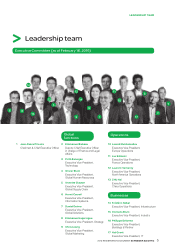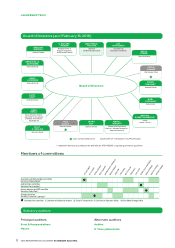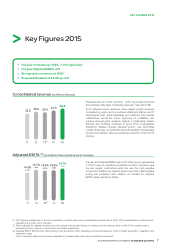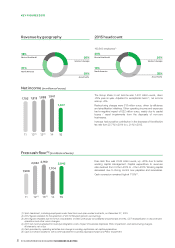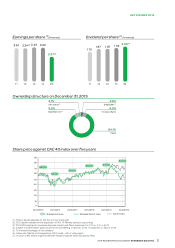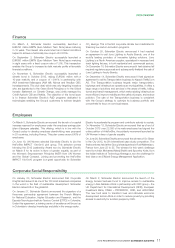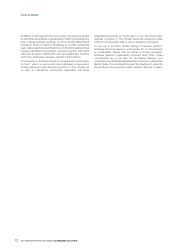APC 2015 Annual Report Download - page 17
Download and view the complete annual report
Please find page 17 of the 2015 APC annual report below. You can navigate through the pages in the report by either clicking on the pages listed below, or by using the keyword search tool below to find specific information within the annual report.
2015 REGISTRATION DOCUMENT SCHNEIDER ELECTRIC 15
OVERVIEW OF THE GROUP’S STRATEGY, MARKETS AND BUSINESSES
1
GROUP STRATEGY ANDMARKETOPPORTUNITIES
Schneider Electric delivers urban efficiency as a trusted partner to
drive collaboration and buy-in of all stakeholders - local and regional
governments, private companies, utilities, real estate developers,
and investors. We provide comprehensive solutions by bringing in
proven technology, integrating operating and information systems,
and enabling a connected, unifi ed approach to decision-making.
Schneider Electric already works with more than 250 cities across
the world, and helps provide visible benefi ts to cities and their
inhabitants :
•up to 30% energy savings;
•up to 15% reduction in water losses;
• as well as environmental, social and economic benefi ts.
Industrialization
Industrialization is driven by the increase in the number of factories
in New Economies, by higher demand for goods, and by effi ciency
improvements as well as retrofi t in m ature c ountries
Manufacturing activities rise as n ew e conomies develop. In
2015 , new economies represented 39 % of world GDP – and
this should reach close to 52 % by 2030. Industrialisation in these
economies will continue in the medium term. Population growth in
n ew e conomies is also driving increased needs for manufactured
goods, with 1.8billion people entering the global consuming class
by 2025. Capex in new economies will also continue to increase in
the medium term from 53 % of world Capex in 2015 to close to 57 %
by 2030. At the same time energy needs will increase accordingly.
The share of global energy demand of non-OECD countries will
continue to rise – from 60% in 2014 to close to 66% by 2030 –
increasing demographics growth , industrialization, urbanization,
and refl ecting affl uence.
In many m ature c ountries, as most companies are looking for
effi ciency gains and facility upgrades, services and other attributes
in manufacturing characteristics (e.g. innovation, time to market,
IoT) are also becoming more important and driving additional
growth potential. Industries account for one-third of the total world
energy consumption. This global industrial energy use is projected
to double by 2050 in the absence of any new environmental
measures. Even with the ambitious emissions reduction policy
changes, the International Energy Agency estimates that we will still
see an increase of at least 50% by 2050. In face of these challenges,
over 100 companies committed to 100% renewable power during
the COP21 through the RE100 initiative.
The growing trend towards increasing of industrialization promises
business growth and expansion opportunities. Schneider Electric
will continue its focus on innovative solutions and to identify
opportunities for further services development, in order to
contribute towards effi ciency and sustainability improvements
in these markets. For long- term sustainable development in n ew
e conomies, Schneider Electric will continue to focus on combining
its global value chain with local partnerships to contribute toward the
economic development through job creation and poverty reduction,
in addition to investments in production capacity and physical &
technological infrastructure to meet the growing demands for
standardized and cost effi cient offerings.
Digitization
In the past 20 years, the Internet has connected 3.2 billion
people together. In the coming ten years, this number will double.
Additionally the Internet will connect 50 billion devices over the
next fi ve years. The increase in connectivity and access to real-
time information is changing our personal and professional lives :
companies are digitizing their operations, often times through SaaS
providers; customers are expecting to have everything online,
from e-training to e-ordering and digital customer service centers;
lastly , and employees are increasingly using online platforms and
tools to collaborate more effi ciently across different countries and
time zones. Digitization is changing the way we work and creating
opportunities for new services.
In energy management, operational technology (OT), the world
of physical equipment control, is converging with information
technology (IT), the world of information processing. Products are
now connected and can be remotely controlled and optimized.
This results in the feasibility of actively implementing active
energy effi ciency, which creates new business models and new
opportunities in smart products, systems and services – such as
smart grid and smart factories.
A smarter grid combines smarter supply (the effi cient integration of
renewable and distributed energy sources and fl exible distribution),
smarter demand (energy-effi cient sites and homes, connected to
the grid), and demand response to balance the two. Schneider
Electric is active in fi ve key domains which form a smart grid:
fl exible distribution, renewable energy integration, effi cient buildings,
electric vehicle charging infrastructure and demand-response.
Microgrids and distributed energy resources (DER) — small-scale
renewable energy sources and energy storage — allow consumers
to produce their own energy and shift to a greener energy mix. The
costs of both solar and storage have been dropping by a factor
of fi ve in the past few years, and analysts expect the renewable
sector to account for up to 50% of new capacity additions by
2030. Schneider Electric is supporting the development of new
battery storage technologies and in 2015 announced EcoBlade, a
smart and scalable energy storage solution for all customer needs.
A cquisitions have also considerably strengthened our offering, f rom
Areva’s Distribution business to Energy Pool and Vizelia in 2010,
and the acquisition of Summit Energy and Telvent in 2011.
The smart manufacturing enterprise is made up of smart machines,
plants and operations with higher levels of embedded intelligence.
Connectivity based on open and standard Internet protocols
and cloud technologies with integrated cybersecurity enables


